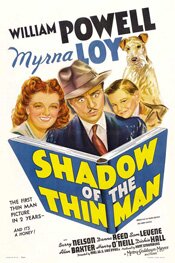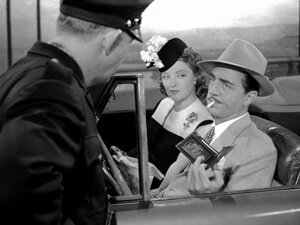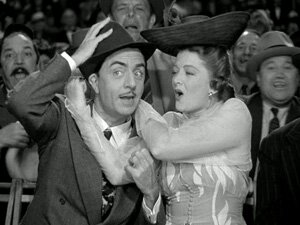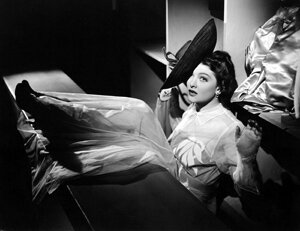 Directed by W.S. Van Dyke
Directed by W.S. Van Dyke
As facile as this may seem, one of the first things that struck me about Shadow of the Thin Man, and a thing I like about all the Thin Man movies, is the titles and their retro font (retro to us, that is).
The tall, thinly lettered titles are imposed over a thin line sketch of Nick, Nora and Asta walking, which itself is set against a stretched shadow of a man — it’s three layered elements — and it is just so stylish.
Simple and superficial as it is, I really do love it.
Of course, there is a movie that follows those titles and in this case it’s a very entertaining one. (No summary is really necessary. There are murders; Nick and Nora reveal the killer.)

This movie, perhaps more than any of the six Thin Man movies, knows what it is, knows what is working in the series and how to best deliver the goods. To begin with, it knows it is entertainment, and simply entertainment, and it focuses on being that. It makes no pretensions to be something that might be called “art.”
That isn’t to denigrate it; it’s a big plus because you can admire the craftsmanship in the performances, the direction, editing and all the elements that go into making it work. It is simply something very well made, like a clock.
Secondly, it knows what works. More than that, it knows why it works.
What works is Nick and Nora (William Powell and Myrna Loy) and the chemistry they have onscreen as a couple.

The movie is particularly aware that it works not just because they are a couple; they are a married couple. It’s the marital framework that really makes the relationship stand out.
But the movie (and why say movie when we should probably be saying director W.S. Van Dyke) also knows that too much can be too much. The Thin Man movies also work because they are whodunits that are distinguished by the characters of the detectors. This is also why a TV series like Columbo worked. It wasn’t the mystery but who was solving the mystery that people were attracted to.
So in Shadow of the Thin Man we get a nice balance between seeing Nick and Nora interacting and the whodunit playing out. We don’t get too much of either; one switches to the other to ensure neither wears out its welcome.
(Compare this balance to the movie that was to follow, The Thin Man Goes Home, where the balance isn’t struck and we end up with what is likely the weakest of film in the series.)
The movie “delivers the goods” by picking up right where the previous movie left off. We start out with Nick and Nora being Nick and Nora so we get what we came for right off the bat. But the film quickly gets into its other key element, the whodunit, so we don’t tire of Nick and Nora or get a sense of “same old, same old.”

Put more succinctly, this movie and movies of its kind work in much the way a good comedy routine works: by knowing what to give and when to stop or change gears so it is always at its peak of appeal and the appeal never wanes through over use. (Or, to employ a common phrase, it doesn’t go to the well too often.) It shuffles back and forth between Nick and Nora and the whodunit, inevitably pulling both together now and again and in a final resolution.
This is a movie to be enjoyed and admired for its mastery of craft. And yes, because it is so damn entertaining.
The original, The Thin Man, worked because of its originality. In the Shadow of the Thin Man we see a formula. But it’s a formula at its peak; it has been understood and tweaked so that the result is a near-perfect Thin Man movie. It’s an example of skill and experience coming together in a wonderful exercise in craft.
The Thin Man Series:
- The Thin Man (1934)
- After the Thin Man (1936)
- Another Thin Man (1939)
- Shadow of the Thin Man (1941)
- The Thin Man Goes Home (1945)
- Song of the Thin Man (1947)



1 Response